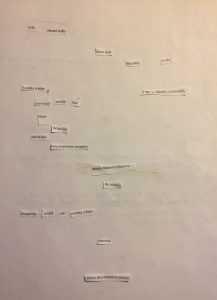In her writing Age Race Class and Sex: Women Redifning Difference, Audre Lorde profoundly writes of (white) feminism: “There is a pretense to a homogeneity of experience, covered by the word sisterhood that does not in fact exist.”(116) Both homogeneity and a sisterhood are non existent because–as she proceeds to examine—a sisterhood cannot exist under the pretense of homogeneity. “As white women ignore their built-in privilege of whiteness and define woman in terms of their own experience alone, then women of Color become “other,” the outsider whose experience and tradition is too “alien” to comprehend.””(117) Something Lorde highlights throughout the text is that it is the differences within feminine identit(ies) are not only to be celebrated, but that in understanding these differences there is an advantage that could lead to true progress. Denying room for difference is to deny room for progress.
At this day in age, the feminist agenda continues to be full of shortcomings involving the exclusion of women of Color in the name of fearful white-guilt. White guilt is one of the pillars upholding our countries modern institutionalized oppression, a notion from which delusional ideas such as a ‘post racial society’ or being ‘color blind’ were born. “Some problems we share as women, some we do not. You fear your children will grow up to join the patriarchy and testify against you, we fear our children will be dragged from a car and shot down in the street, and you will turn your backs upon the reasons they are dying.” (119) This excerpt follows a point Lorde makes involving this willful ignorance of white women upholding the patriarchy and in turn oppressing women. Lorde states: “For white women there is a wider range of pretended choices and rewards for identifying with patriarchal power and its tools.” She continues to name points of seduction to align with the patriarchy, suggesting that if white women “…hate the right people, and marry the right man, then you will be able to coexist with the patriarchy in relative peace…”. This holds true for modern feminism as is has since women joined the work force.
The white-toxic masculinity that we hear commonly used in progressive rhetoric involving social reform extends to women as well in these areas of which Lorde addresses. White toxic feminism mirrors it exactly. For instance, white women taught to adopt practices of climbing social ladders and advance oneself in the workplace by tearing other women down by highlighting what makes you better than they are. Lorde concludes “The old patterns, no matter how cleverly rearranged to imitate progress, still condemn us to cosmetically altered repetitions of the same old exchanges, the same old guilt, hatred, recrimination, lamentation, and suspicion.” (123) Here she summarizes one of the key points of the essay, the refusal to use history as a means of learning how to make real progress. To divide and conquer may be an effective means of dismantling a corrupt power, but it is also the most heavily used tool of the patriarchal structure in suppressing the feminist movement. By ignoring racist actions and by excluding the voices and experiences of Colored women, the feminist movement is no movement at all.
Two questions I propose are:
What parts of the text stuck out to you and reminded you of something you’ve either observed or participated in that could have been oppressing to women of Color?
How does Lorde address the issues surrounding the so-called ‘progressive movements’ that prevent progress from happening?
Audre Lorde, “Age, Race, Class and Sex: Women Redefining Difference,” in Sister Outsider: Essays and Speeches. (Freedom, CA: Crossing Press, 1984).

